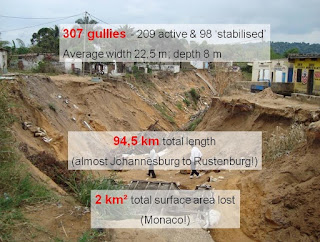Favorite Geology Word: Isopach (Accretionary Wedge #35)
This my first post to Accretionary Wedge Geoscience Blog Carnival. The current topic for AW#35 is “ What's Your Favorite Geology Word? ” hosted by Evelyn Mervine.
Pronunciation: 'ī-sə-ˌpak
Date: approximately 1918
Isopach is a Map of the thickness variation of a stratigraphic unit; used in geological exploration for oil and for underground structural analysis. I always love to draw it due to it's importance to evaluate a reservoir or aquifer in subsurface geology.
My favorite Example
Five wells were drilled (I-V), which well no. (I) at the middle with respect to the others as shown on the sketch. The vertical thickness in meters of sands formation in these wells are as follows:
Sandstone in this example is oil-bearing bed we need to know which direction it's thickness increased to produce the maximum oil production from it.
The thickness of sands formation incease outer the center
thickness in NE-SW direction is the maximum 100 m
and in NW- SE direction is 75 m
Isopach map helped us in this example to determine the direction that the thickness of sands formation increased.
For a list of other geologists’ favorite words, check out the Accretionary Wedge #35.
My Favorite Geology Word Is - Isopach
Definition: A contour that connects points of equal thickness. Commonly, the isopachs, or contours that make up an isopach map, display the stratigraphic thickness of a rock unit as opposed to the true vertical thickness. Isopachs are true stratigraphic thicknesses; i.e., perpendicular to bedding surfaces.(Source)
Pronunciation: 'ī-sə-ˌpak
Date: approximately 1918
Structure map includes an isopach of the reservoir with contours shown in red dashes. Venezuela Well Evaluation Conference, 1997, page 2-26
My favorite Example
Five wells were drilled (I-V), which well no. (I) at the middle with respect to the others as shown on the sketch. The vertical thickness in meters of sands formation in these wells are as follows:
| Well no |
I
|
II
|
III
|
IV
|
V
|
Sands
|
25
|
100
|
75
|
100
|
75
|
Sandstone in this example is oil-bearing bed we need to know which direction it's thickness increased to produce the maximum oil production from it.
 |
| Isopach map for sands formation with contour interval 20 CM |
Isopach map for sands formation with contour interval 20 CM
The thickness of sands formation incease outer the center
thickness in NE-SW direction is the maximum 100 m
and in NW- SE direction is 75 m
Isopach map helped us in this example to determine the direction that the thickness of sands formation increased.
For a list of other geologists’ favorite words, check out the Accretionary Wedge #35.




Comments
Post a Comment